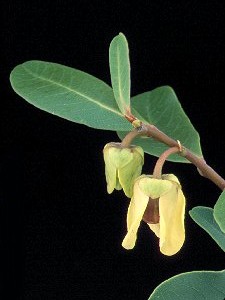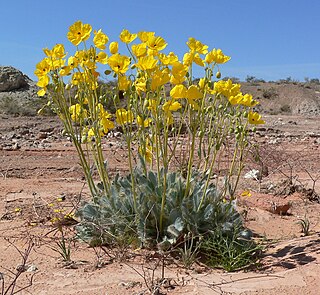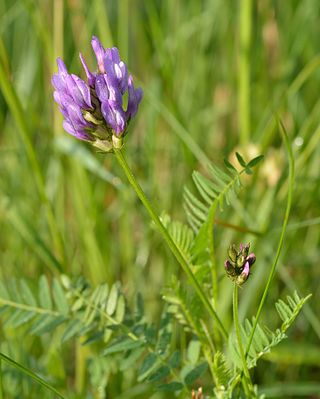
The Santa Cruz cypress is a species of North American tree within the Cypress family. The species is endemic to the Santa Cruz Mountains within the Santa Cruz and San Mateo counties of west-central California. The U.S. Fish and Wildlife Service listed the species on the Endangered Species Act in 1987 due to increasing threats from habitat loss and disruption of natural forest fire regimes. In 2016, the conservation status of the Santa Cruz cypress changed to Threatened. The cited reasoning was a decrease in threats against their habitat.
Dan James Pantone is an American ecologist and conservationist with a Ph.D. from the University of California, Davis. A former professor at Texas A&M University, Dr. Pantone is a researcher who has published numerous refereed articles on agroecology and sustainable agriculture. In addition, he is a specialist in Geographical Information Systems (GIS) which he has used to help conserve endangered species. Dr. Pantone has established his broad experience in numerous scientific disciplines by publishing diverse articles ranging from the biological control of pests to the conservation biology of endangered species.

Bidens amplectens, the Waiʻanae kokoʻolau, is a species of flowering plant in the family Asteraceae. It belongs to the genus Bidens, collectively called kokoʻolau or koʻokoʻolau in the Hawaiian language. It is found in coastal and dry lowland habitats in the Waiʻanae Range on Oʻahu. It is threatened by habitat loss due to the spread of invasive weeds and brush fires. The species is also threatened by climate change and habitat degradation, and herbivory. Bidens amplectens is currently listed as endangered under the Endangered Species Act.

Asimina tetramera, commonly known as the four-petal pawpaw, is a rare species of small tree or perennial shrub endemic to Martin and Palm Beach Counties in the state of Florida. The species is currently listed as endangered under the Endangered Species Act and as endangered by the International Union for Conservation. The four-petal pawpaw is part of the Annonaceae family alongside other Asimina species.

Astragalus pycnostachyus var. lanosissimus, the Ventura marsh milk-vetch, is a short-lived, herbaceous perennial in the pea family Fabaceae,

Astragalus trichopodus is a species of legume known by the common name Santa Barbara milk vetch. It is native to southern California and Baja California, where it grows in several types of open habitat, including in the Transverse Ranges and Mojave Desert.

Arctomecon humilis is an endangered, endemic species found only in the Dixie Corridor in southwest Utah. A. humilis grows in a very harsh desert environment, requiring a specific soil type. The plant's common name is dwarf bear-poppy, which is indicative of the plant's jagged, three “clawed” leaves. The poppy is a perennial plant, meaning it blooms annually. The dwarf bear-poppy is protected under the Endangered Species Act as of 1979. The plant is threatened by urban development, off-road vehicle use, and mining. Although hard to estimate, its population has diminished significantly over the years. There are several plans to protect the poppy, including making the land it occurs on a protected area.

Astragalus brauntonii is a rare species of milkvetch known by the common name Braunton's milkvetch. It is endemic to California, where it is known from fewer than 20 extant occurrences in the hills and mountains surrounding the Los Angeles Basin in Southern California. This is a federally listed endangered species in the United States.

Astragalus jaegerianus is a rare species of milkvetch known by the common name Lane Mountain milkvetch. The plant was named for the biologist Edmund Jaeger, who first documented it in 1939.

Astragalus pycnostachyus is a species of milkvetch known by the common name marsh milkvetch. It is endemic to the coastline of California, where it grows in wet saline habitat such as marshes.

Arctomecon californica is a species of poppy known by several common names, including California bearpoppy, Las Vegas bearpoppy, golden bearpoppy, and yellow-flowered desert poppy. It is a perennial herb that is native to the eastern Mojave Desert.

Astragalus ampullarioides is a rare species of milkvetch known by the common name Shivwits milkvetch. It was previously classified as a variety of Astragalus eremiticus. It is endemic to Washington County, Utah, where it is known from only seven populations. Estimates of the total number of individuals range from 1000 to 4200. The species occurs in desert scrub and woodlands on the Chinle Formation. It is a federally listed endangered species.

Astragalus desereticus is a rare species of milkvetch known by the common name Deseret milkvetch. It is endemic to Utah County, Utah, where it is known from only one population. It was thought to be extinct until 1981 when this population was discovered. The population contains 5,000 to 10,000 plants on an area of land covering less than 300 acres. It is vulnerable to damage from grazing cattle, which eat the plant and trample the soil, and from development and erosion. This is a federally listed threatened species.

Astragalus osterhoutii, or the Osterhout milkvetch or Kremmling milkvetch, is an endangered species of milkvetch, discovered and collected in 1905 at Sulfur Spring in Grand County Colorado by Colorado botanist George Everett Osterhout for which the plant was named. It is found in the U.S. state of Colorado, in a 13 kilometres (8.1 mi) radius near the town of Kremmling.

Astragalus microcymbus is a species of flowering plant in the legume family known by the common name Skiff Milkvetch. It is endemic to Colorado in the United States, where it is known from Gunnison County and the edge of Saguache County. It was discovered in 1945 by Rupert Barneby, a British botanist. Currently, Skiff Milkvetch is experiencing population declines and is listed as Threatened.
Astragalus anisus is a species of flowering plant in the legume family known by the common name Gunnison milkvetch. It is endemic to Colorado in the United States, where it is limited to the Gunnison Basin of Gunnison and Saguache Counties.

Astragalus danicus, known as purple milk-vetch, is a species of flowering plant in the family Fabaceae (legumes), which is native to Europe.
Brickellia mosieri, the Florida brickell-bush, is a North American herbaceous plant in the family Asteraceae. It grows in Pine Rocklands in Florida, preferring low-nutrient sand close to sea level. It is characterized by small, round, rod-shaped flowers that are either brown or white. Since 1999, the total population of the Florida brickell-bush has declined by 50% due to a number of threats. Currently, it is listed as “endangered wherever found” under the ESA

Acanthomintha ilicifolia, known by the common name San Diego thornmint, is a rare species of flowering plant in the mint family. It is native to Baja California and San Diego County, California, where it is a resident of the chaparral and coastal sage scrub plant communities and vernal pools.
Perdita meconis, the Mojave poppy bee, is a rare bee species that was described in 1993. The Mojave poppy bee has been petitioned for protection under the Endangered Species Act due to pressures in their native range such as invasive species, habitat fragmentation, gypsum mining, and climate change.


















